
perennial plants for sales
Long-lasting blooms through summer
Drought-tolerant for low-water gardens
Attracts pollinators like butterflies and bees
Thrives in
ZONE 3ZONE 4ZONE 5ZONE 6ZONE 7ZONE 8ZONE 9Planting Season:
Year-RoundWhen you add one plant to cart, it automatically adds the second one free on Bogo deals.
Yellow Coneflower is a native perennial wildflower with striking, golden daisy-like flowers and a central cone. It attracts pollinators and adds bright color to prairies and gardens. It is a delightful addition to any landscape and offers numerous attributes that make it popular among gardeners.
These plants, which also produce achenes fruit, can grow up to three feet tall and have rough stems and leaves. A single flowerhead grows on an unbranched stem from the plant's base leaves. Each flower can have up to 13 drooping golden petals that are 1½–3½ inches long and have notched ends. As they dry, the fruits within their bur-like dome-shaped heads become black.
A long flowering season is excellent for coordinating plant combinations and flower arrangements. It blooms for one to two months, beginning early and ending in late summer. As the blooming season progresses, the plant's cone-shaped green core eventually becomes a deep purple or brown. Remember that most of these flowers will fully bloom in their second or third year of growth. These plants' fruit usually develops in late summer or fall. The achenes can display four little teeth at their tips, giving them an oblong-angular form.
These plants are a great addition to any garden since they draw pollinators and birds. Birds love the seeds from the flower's cone-shaped core, and bees and butterflies also visit the blossom. From a design perspective, the cone-shaped seed heads with their sharp points make them a one-of-a-kind architectural feature.
The textured leaves of this plant, also known as perennial black-eyed Susans, provide movement and contrast to any garden. These plants stand out because of their large, glossy leaves resembling cabbage leaves. You can use the textured foliage to increase the visual appeal of your yard. Their greenery is an excellent addition to naturalized areas, rain gardens, and gardens.
What is It
They are a beautiful perennial plant that has golden petals and a large visible center cone. It is loved by gardeners because it has perky flowers that brighten up gardens or any part of the outdoor space.
Where Can They Grow
They are adaptable to various growing conditions ranging from full sun to fully shaded areas. They are resistant to dry spells, which makes them suitable for any landscape.
Are They Easy to Maintain
They are low-maintenance plants. After they have set, they need little attention and are resistant to pests and diseases, which makes them suitable for growing by beginner gardeners.
Do They Attract Wildlife
These flowers are a favorite for pollinators such as bees and butterflies. Their seeds are a source of food for various birds, thus making your garden quite lively.
How Long Do They Bloom
Flowering occurs from early summer to late fall and that is why the Yellow coneflowers are known to have a long blooming period. This extended display ensures your garden stays colorful for many months.

Bloom Season
Fall
Bloom/Foliage Color
Yellow
Height at Maturity
Under 12"
Care
Yellow Coneflower (Echinacea paradoxa) thrives with regular watering, especially during dry spells. Deadhead finished flowers to promote continued flowering and promote new growth. Provide well-draining soil and space plants about 12-18 inches apart for optimal air circulation and growth.
Plant Reproduction
Yellow Coneflower Spreads by seeds and underground stem structures called rhizomes
Shipping date depends on the date displayed and chosen when you order from the product's page.
We only accept returns on plants verified dead. If you think your plants have died, we offer a 1 year warranty, please use use this File a Claim Link to verify dead plants and start with return warranty process.




Wildlife Magnet:
Its bright blooms attract butterflies and bees, enhancing the biodiversity of your garden.
Long Blooming Season:
This plant offers a lengthy blooming period from midsummer to fall, ensuring long-lasting beauty.
Bright and Cheerful Blooms:
The Yellow Coneflower produces vibrant, daisy-like flowers that bring a splash of sunshine to any garden.
Versatile Use:
Ideal for garden beds, borders, and wildflower meadows, adding charm and color to any landscape.
Caring Tips
Each box contains detailed care instructions and information about your product. But here's the basics.
Care Tips
Yellow Coneflower (Echinacea paradoxa) thrives with regular watering, especially during dry spells. Deadhead finished flowers to promote continued flowering and promote new growth. Provide well-draining soil and space plants about 12-18 inches apart for optimal air circulation and growth.
Light Requirements
Yellow Coneflower flourishes in full sun to partial shade. It favors at least six hours of direct sunlight daily but can tolerate light shade, especially in hotter climates. Ample sunlight ensures vibrant blooms and healthy growth throughout the season.
Hardy Planting Zones
3 • 4 • 5 • 6 • 7 • 8 • 9
How often should I water my plants?
How do I know if my plant is getting too much or too little sunlight?
What should I do to prepare my plants for winter?
What are the signs that my plant needs fertilizing?
How can I prevent pests from damaging my plants?
How do I choose the right plant for my climate zone?